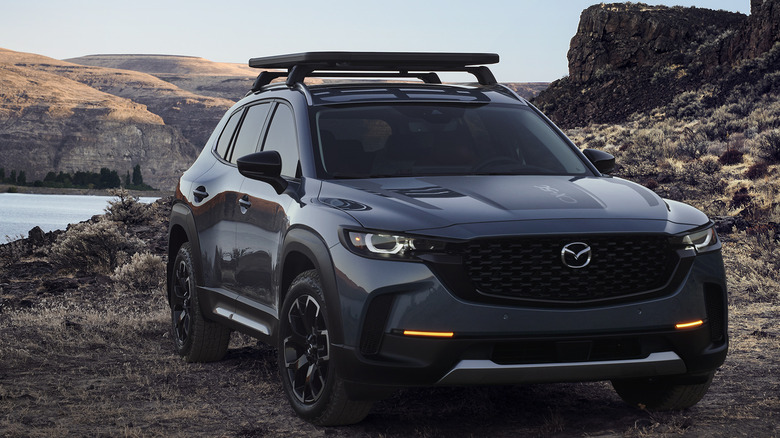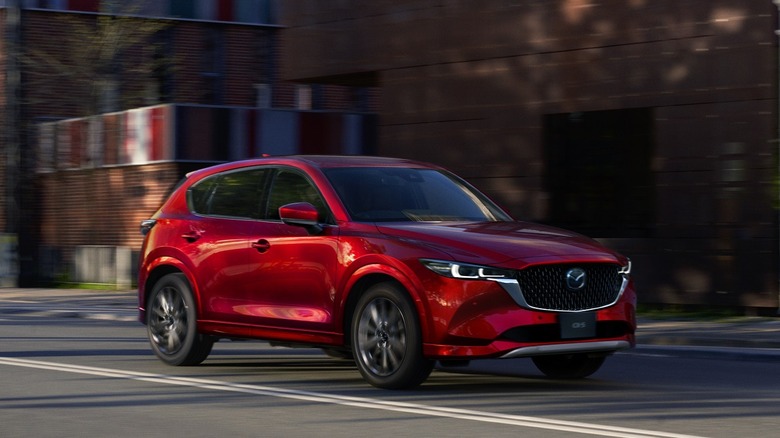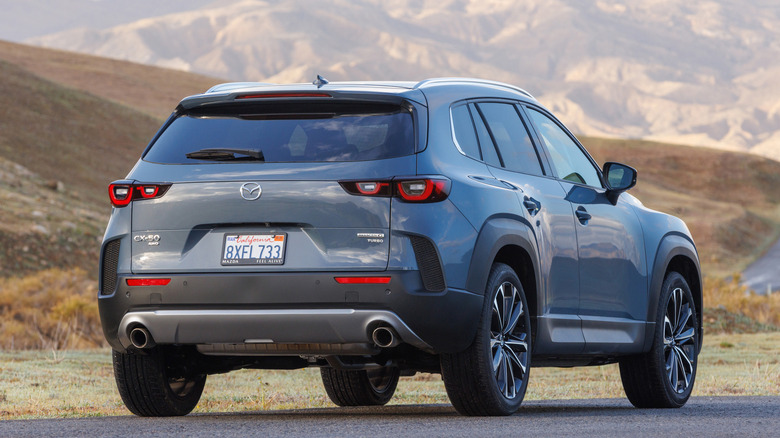
Historically, Mazda has always done things a little differently, instead of following trends. Most famously, Mazda pioneered rotary engine technology, launching several rotary-powered cars over the decades, most famously the RX-7 and RX-8. Fast-forward to today, though, and Mazda conforms to the norm a little more than before, in the form of its comprehensive range of SUVs. Among these models are the CX-5 and CX-50 -- compact SUVs with prices that start at around $30,000, seat five occupants, and share
powertrains.
Picking between the two may prove to be quite a tricky task, as in many ways, the CX-5 and CX-50 are remarkably similar to one another. It may seem strange for Mazda to go through the trouble of bringing two nearly identical SUVs to the market at the same time, but the Japanese automaker has ensured they also differ just enough from one another. The CX-50, for example, sports a more rugged and adventurous aesthetic and is also longer and lower than the CX-5. It also has a hybrid powertrain, which isn't available on the CX-5. On the other hand, the CX-5 has some tricks up its sleeve that may appeal to certain buyers, including offering more space for occupants and slightly more cargo room with the rear seats folded down.
Read more: 9 Cheap Cars That Look Expensive
The CX-5 And CX-50's Size Differences

Both the CX-50 and CX-5 make for fine compact SUV offerings, with ample room for five and a decent amount of cargo. While they are undeniably similar, pulling out the tape measure reveals some key differences, and arguably most apparent is the differing stances between these two SUVs.
The CX-5 has more of a typical SUV build, with a traditional silhouette and high roofline of 66.1 inches tall, with 7.6 inches of ground clearance. The CX-50, by way of contrast, is noticeably lower at 63.5 inches tall, despite boasting a higher ground clearance of 8.3 inches. The latter offers the CX-50 a slightly more rugged and off-road-ready aesthetic, while the lower roofline provides a sleeker look that contrasts well against the CX-5's more conventional design.
More differences reveal themselves on the inside. As you may imagine, the CX-5's taller roofline enables it to offer more headroom to occupants: 39.7 inches for front passengers and 39 inches for those in the back. That's 0.8 and 0.4 of an inch more than the CX-50, respectively. In terms of cargo space, picking a winner is a tough call. While the CX-50 offers more room behind the second row, at 31.4 cubic feet to the CX-5's 29.1, the CX-5 wins with the seats down, providing a maximum of 58.1 cubic feet compared to the 56.3 available in the CX-50. The extra headroom and cargo space may be why the CX-5 is Mazda's current best-selling model, and one of the most successful Mazda models of all time.
Comparing Specs Between Mazda's Compact SUVs

If size differences haven't helped you separate the two Mazda SUVs, then perhaps checking out the unique features of each will prove more fruitful. The key difference is that the CX-50 is available with a hybrid powertrain, while the CX-5 is not. We recently tested a 2024 Mazda CX-50 Hybrid, and while it felt a touch down on power at times, we were impressed by the fuel economy and pleased to see the all-wheel-drive feature as standard.
The CX-50 isn't finished there, either. As Mazda's more adventurously spirited SUV, it can also come equipped with a whole host of light off-roading goodies, too, most notably in the Turbo Meridian trim. Here, the CX-50 comes with 18-inch alloy wheels, shod in Falken Wildpeak all-terrain tires. The optional Apex Package, which will set you back $1,235, adds a smart roof rack, black lug nuts, and matching splash guards, too, further emphasizing the cool off-roading aesthetic.
While the CX-5 doesn't get any off-roading gear, it does offer some desirable trim packages of its own. Both Carbon and Signature models are available, with the former sporting darkened trim pieces and alloy wheels, plus exclusive terracotta leather-trimmed front seats. The Signature trim has a few luxurious interior amenities of its own, including Nappa leather-trimmed seats, layered wood trim, and ambient lighting.
Want the latest in tech and auto trends? Subscribe to our free newsletter for the latest headlines, expert guides, and how-to tips, one email at a time.
Read the original article on SlashGear.










